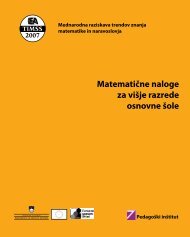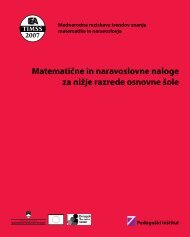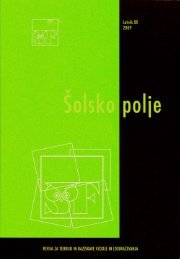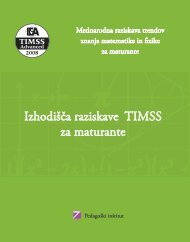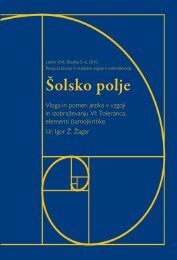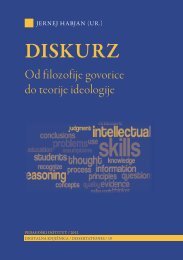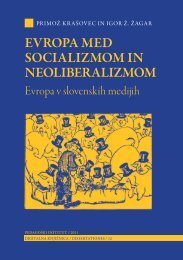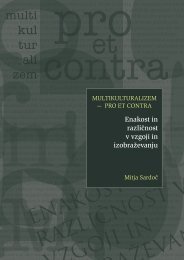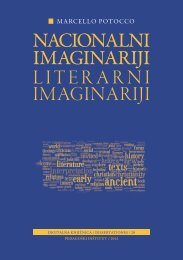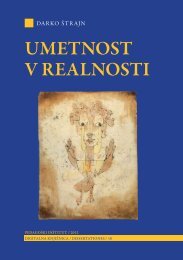52 ŠOLSKO POLJE LETNIK <strong>XX</strong> ŠTEVILKA 5/6gent? Judging from the lists we have just seen there are no rules or criteria,the only methodological precept seems to be: »anything goes«!In philosophy (of science), from 14th century onward, we have somethingcalled Occam’s razor. It could be phrased as Entia non sunt multiplicandapraeter necessitatem, which could be roughly translated as »entitiesmust not be multiplied beyond necessity.« Or in alternative version:Pluralitas non est ponenda sine necessitate, which translates as »pluralityshould not be posited without necessity.«In the lists of topoi we have just browsed (through), Occam’s razorwas, no doubt, left without work. We’ve seen identical/similar bundles oftopoi for different purposes or occasions, we’ve seen different bundlesof topoi for identical/similar purposes or occasions, we’ve seen differentbundles of topoi for different occasion, and we’ve seen pretty exotic bundlesof topoi for pretty particular/singular purposes. Which leads us to akey question: can anything be or become a topos? And, consequentially,what actually is a topos?But before we try to answer these questions, let us have a look at howthese topoi are used in the respective works.In Discourse and Discrimination (Reisigl & Wodak, 2001: 75) as wellas in »The Discourse-Historical Approach« (Wodak, 2006: 74), we can findthe following definition of the topos of advantage (many more topoi arelisted, of course, but for the purpose of this article, I can only discuss afew):»The topos of advantage or usefulness can be paraphrased by meansof the following conditional: if an action under a specific relevant pointof view will be useful, then one should perform it (...) To this toposbelong different subtypes, for example the topos of ‘pro bono publico’(‘to the advantage of all’), the topos of ‘pro bono nobis’ (to the advantageof us’), and the topos of ‘pro bono eorum’ (‘to the advantageof them’).«And then the definition is illustrated by the following example:»In a decision of the Viennese municipal authorities (...), the refusal ofa residence permit is set out as follows:Because of the private and family situation of the claimant, the refusalof the application at issue represents quite an intrusion into herprivate and family life. The public interest, which is against the residencepermit, is to be valued more strongly than the contrasting pri-
TOPOI IN CRITICAL DISCOURSE ANALYSIS53vate and family interests of the claimant. Thus, it had to be decidedaccording to the judgement.«If a topos is supposed to connect an argument with a conclusion, onewould expect that a reconstruction would follow, namely, what is the argument(in the quoted fragment), what is the conclusion (in the quotedfragment), how the above mentioned topos is connecting the two, andwhere is the analysis (of the quoted fragment). Unfortunatelly, all theseelements are missing (including the analysis); the definition and the quotedfragment are all there is.It is also interesting to follow, how the working of topoi is described(especially in Discourse & Discrimination which is the most thorough inthis respect): topoi are mostly »employed« (p. 75), or »found« (p. 76), whenspeaking about their supposed application in different texts, but also »tracedback (to the conclusion rule)« (p. 76) or »based on (conditionals)« (p.77), when speaking about their possible frames of definitions. How topoiare »based on (conditionals)«, or »traced back (to the conclusion rule)«,and how these operations relate to argument(s) and conclusion(s) thattopoi are supposed to connect is not explained.Let us have a look at another example, this time from Discourse ofPolitics in Action (Wodak, <strong>2009</strong>: 97):»Among MEPs 5 no one cluster characteristics is particularly prominent;however, most MEPs mention that member states share a certaincultural, historical and linguistic richness that binds them together,despite differences in specifics; this topos of diversity occurs inmost official speeches (Weiss, 2002). Among the predicational strategiesemployed by the interviewees, we see repeated reference to acommon culture and past (topos of history, i.e. shared cultural,historical and linguistic traditions; similar social models) anda common present and future (i.e. European social model; ‘added value’of being united; a way for the future). Morover, if identity is tosome extent ‘based on the formation of sameness and difference’ (toposof difference; strategy of establishing uniqueness; Wodak etal., 1993: 36-42), we see this in the frequent refferal to Europe, especiallyin terms of its social model(s), as not the US or Asia (most prominently,Japan).«Let us try to reconstruct the »topological« part of this analysis.
- Page 3: VSEBINA LETNIK XX ŠTEVILKA 5/6 Z
- Page 7 and 8: UVODNA NOTICAIgor Ž. ŽagarTole pi
- Page 9 and 10: ZA KAJ GRE V KAD - PREGLEDZGODOVINE
- Page 11 and 12: ZA KAJ GRE V KAD - PREGLED ZGODOVIN
- Page 13: ZA KAJ GRE V KAD - PREGLED ZGODOVIN
- Page 17 and 18: ZA KAJ GRE V KAD - PREGLED ZGODOVIN
- Page 19 and 20: ZA KAJ GRE V KAD - PREGLED ZGODOVIN
- Page 21 and 22: ZA KAJ GRE V KAD - PREGLED ZGODOVIN
- Page 23 and 24: ZA KAJ GRE V KAD - PREGLED ZGODOVIN
- Page 25 and 26: ZA KAJ GRE V KAD - PREGLED ZGODOVIN
- Page 27 and 28: DISKURZ: FOUCAULT, LACLAU TERZAPOPA
- Page 29 and 30: DISKURZ: FOUCAULT, LACLAU TER ZAPOP
- Page 31 and 32: DISKURZ: FOUCAULT, LACLAU TER ZAPOP
- Page 33 and 34: DISKURZ: FOUCAULT, LACLAU TER ZAPOP
- Page 35 and 36: DISKURZ: FOUCAULT, LACLAU TER ZAPOP
- Page 37 and 38: DISKURZ: FOUCAULT, LACLAU TER ZAPOP
- Page 39 and 40: DISKURZ: FOUCAULT, LACLAU TER ZAPOP
- Page 41 and 42: DISKURZ: FOUCAULT, LACLAU TER ZAPOP
- Page 43 and 44: DISKURZ: FOUCAULT, LACLAU TER ZAPOP
- Page 45 and 46: DISKURZ: FOUCAULT, LACLAU TER ZAPOP
- Page 47 and 48: DISKURZ: FOUCAULT, LACLAU TER ZAPOP
- Page 49 and 50: TOPOI IN CRITICAL DISCOURSE ANALYSI
- Page 51 and 52: TOPOI IN CRITICAL DISCOURSE ANALYSI
- Page 53: TOPOI IN CRITICAL DISCOURSE ANALYSI
- Page 57 and 58: TOPOI IN CRITICAL DISCOURSE ANALYSI
- Page 59 and 60: TOPOI IN CRITICAL DISCOURSE ANALYSI
- Page 61 and 62: TOPOI IN CRITICAL DISCOURSE ANALYSI
- Page 63 and 64: TOPOI IN CRITICAL DISCOURSE ANALYSI
- Page 65 and 66: TOPOI IN CRITICAL DISCOURSE ANALYSI
- Page 67 and 68: TOPOI IN CRITICAL DISCOURSE ANALYSI
- Page 69 and 70: TOPOI IN CRITICAL DISCOURSE ANALYSI
- Page 71 and 72: TOPOI IN CRITICAL DISCOURSE ANALYSI
- Page 73 and 74: TOPOI IN CRITICAL DISCOURSE ANALYSI
- Page 75 and 76: TOPOI IN CRITICAL DISCOURSE ANALYSI
- Page 77 and 78: University of Queensland, Centre fo
- Page 79 and 80: JOURNALISTIC (RE)PRODUCTION OF HIST
- Page 81 and 82: JOURNALISTIC (RE)PRODUCTION OF HIST
- Page 83 and 84: JOURNALISTIC (RE)PRODUCTION OF HIST
- Page 85 and 86: JOURNALISTIC (RE)PRODUCTION OF HIST
- Page 87 and 88: JOURNALISTIC (RE)PRODUCTION OF HIST
- Page 89 and 90: JOURNALISTIC (RE)PRODUCTION OF HIST
- Page 91 and 92: JOURNALISTIC (RE)PRODUCTION OF HIST
- Page 93 and 94: JOURNALISTIC (RE)PRODUCTION OF HIST
- Page 95 and 96: JOURNALISTIC (RE)PRODUCTION OF HIST
- Page 97 and 98: JOURNALISTIC (RE)PRODUCTION OF HIST
- Page 99 and 100: JOURNALISTIC (RE)PRODUCTION OF HIST
- Page 101 and 102: JOURNALISTIC (RE)PRODUCTION OF HIST
- Page 103 and 104: THE VOICE OF AN AGENDA-SETTINGAUTHO
- Page 105 and 106:
THE VOICE OF AN AGENDA-SETTING AUTH
- Page 107 and 108:
THE VOICE OF AN AGENDA-SETTING AUTH
- Page 109 and 110:
THE VOICE OF AN AGENDA-SETTING AUTH
- Page 111 and 112:
THE VOICE OF AN AGENDA-SETTING AUTH
- Page 113 and 114:
THE VOICE OF AN AGENDA-SETTING AUTH
- Page 115 and 116:
THE VOICE OF AN AGENDA-SETTING AUTH
- Page 117 and 118:
THE VOICE OF AN AGENDA-SETTING AUTH
- Page 119 and 120:
THE VOICE OF AN AGENDA-SETTING AUTH
- Page 121 and 122:
THE VOICE OF AN AGENDA-SETTING AUTH
- Page 123 and 124:
THE VOICE OF AN AGENDA-SETTING AUTH
- Page 125 and 126:
THE VOICE OF AN AGENDA-SETTING AUTH
- Page 127 and 128:
THE VOICE OF AN AGENDA-SETTING AUTH
- Page 129 and 130:
THE VOICE OF AN AGENDA-SETTING AUTH
- Page 131 and 132:
THE VOICE OF AN AGENDA-SETTING AUTH
- Page 133 and 134:
THE VOICE OF AN AGENDA-SETTING AUTH
- Page 135 and 136:
‘68 KOT HKRATNA KRIZA EVROPSKEGAZ
- Page 137 and 138:
‘68 KOT HKRATNA KRIZA EVROPSKEGA
- Page 139 and 140:
‘68 KOT HKRATNA KRIZA EVROPSKEGA
- Page 141 and 142:
‘68 KOT HKRATNA KRIZA EVROPSKEGA
- Page 143 and 144:
‘68 KOT HKRATNA KRIZA EVROPSKEGA
- Page 145 and 146:
‘68 KOT HKRATNA KRIZA EVROPSKEGA
- Page 147 and 148:
‘68 KOT HKRATNA KRIZA EVROPSKEGA
- Page 149 and 150:
‘68 KOT HKRATNA KRIZA EVROPSKEGA
- Page 151 and 152:
‘68 KOT HKRATNA KRIZA EVROPSKEGA
- Page 153 and 154:
‘68 KOT HKRATNA KRIZA EVROPSKEGA
- Page 155 and 156:
‘68 KOT HKRATNA KRIZA EVROPSKEGA
- Page 157 and 158:
‘68 KOT HKRATNA KRIZA EVROPSKEGA
- Page 159 and 160:
POVZETKI/ABSTRACTSZA KAJ GRE V KAD
- Page 161 and 162:
POVZETKI / ABSTRACTS159NOVINARSKA (
- Page 163 and 164:
POVZETKI / ABSTRACTS161‘68 AS PAR
- Page 165 and 166:
AVTORJI/AUTHORSRuth WodakRuth Wodak
- Page 168 and 169:
166 ŠOLSKO POLJE LETNIK XX ŠTEV
- Page 170 and 171:
168 ŠOLSKO POLJE LETNIK XX ŠTEV
- Page 172:
ZAHVALARevija Šolsko polje izhaja




